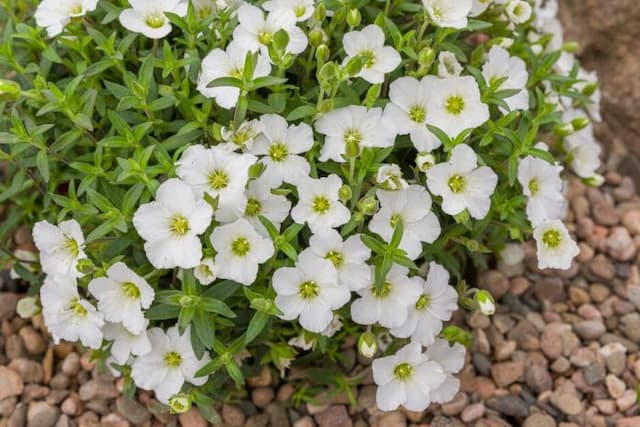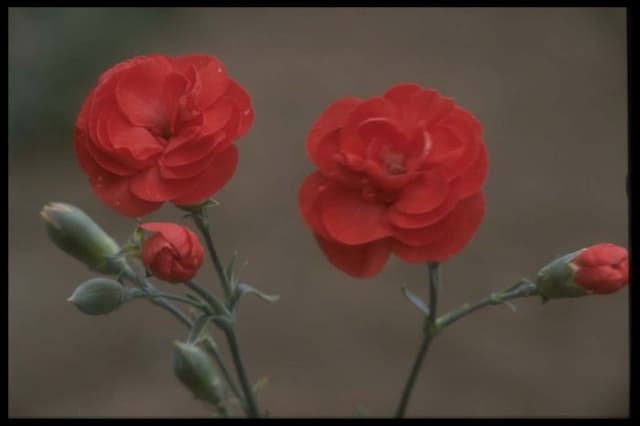Pink Dianthus 'Haytor Rock' (p)

ABOUT
Dianthus 'Haytor Rock' is a charming plant known for its clumping habit and grass-like, blue-green foliage that forms a tidy mound. Throughout its blooming period, it showcases plentiful, frilly-edged flowers that can be described as having a lacy appearance. These flowers exhibit a lovely pink hue with a distinctive, slightly darker ring near the fringed petal edges, commonly referred to as "pinking" on the petals. The blooms are often noted for their rich, spicy fragrance that adds to the plant's allure. The flowering stems are sturdy and rise above the foliage, creating a delightful contrast between the soft leaves and the vibrant flowers. The overall impression of Dianthus 'Haytor Rock' is that of a refined and elegant plant with a burst of color and scent, ideal for ornamental garden display.
About this plant
 Names
NamesFamily
Caryophyllaceae
Synonyms
Pink, Sweet William, Carnation
Common names
Dianthus 'Haytor Rock'
 Toxicity
ToxicityTo humans
Dianthus, commonly known as carnation, is not generally toxic to humans. Ingesting parts of the plant is unlikely to cause severe poisoning. However, as with any plant, individual reactions can vary, and some people may experience mild discomfort or gastrointestinal upset if they consume parts of the carnation.
To pets
Carnation, or Dianthus, is considered to be mildly toxic to pets, such as dogs and cats. If ingested, it can cause mild gastrointestinal symptoms, including vomiting, diarrhea, and possibly mild dermatitis. The severity of the symptoms typically depends on the amount consumed, but serious complications are rare with this plant. If you suspect your pet has consumed a significant amount of carnation, it is advisable to consult with a veterinarian.
 Characteristics
CharacteristicsLife cycle
Perennials
Foliage type
Evergreen
Color of leaves
Blue-green
Flower color
Pink
Height
1 foot (30 cm)
Spread
1 foot (30 cm)
Plant type
Herb
Hardiness zones
5
Native area
Europe
Benefits
 General Benefits
General Benefits- Aesthetic Appeal: Dianthus 'Haytor Rock' adds vibrant color and texture to gardens with its pinkish-purple flowers and blue-green foliage.
- Seasonal Interest: Its long blooming period from late spring to early fall provides extended visual interest.
- Fragrance: The flowers emit a distinctive sweet and spicy clove-like scent, enhancing the sensory experience of a garden.
- Drought Tolerance: Once established, it is relatively drought-resistant, making it suitable for xeriscaping and low-water gardens.
- Attracts Pollinators: The flowers attract bees and butterflies, supporting local ecosystems and pollination.
- Low Maintenance: This plant generally requires minimal upkeep, with occasional deadheading to promote further blooming.
- Versatility: It can be used in borders, containers, rockeries, and as a ground cover, offering numerous landscaping options.
- Cold Hardy: It is capable of withstanding cooler temperatures and can thrive in a range of climate zones.
- Rabbit and Deer Resistant: Its foliage and flowers are less palatable to rabbits and deer, reducing the likelihood of damage from these animals.
 Medical Properties
Medical PropertiesThis plant is not used for medical purposes.
 Air-purifying Qualities
Air-purifying QualitiesThis plant is not specifically known for air purifying qualities.
 Other Uses
Other Uses- Dianthus 'Haytor Rock' can be used as a natural fabric dye, providing a range of colors from yellow to green depending on the mordant used.
- The petals of Carnations are edible and can be used to add color and a sweet taste to desserts like cakes or cupcakes.
- Pressed Carnation flowers can be used for decorative purposes in scrapbooking or as a feature in homemade paper crafts.
- Aromatic Carnation flowers can be placed in drawers or closets as natural sachets to impart a pleasant fragrance to linens and clothes.
- Carnation petals can be steeped in hot water to make a fragrant floral tea that is caffeine-free.
- They can be used in crafting perfumes or essential oils, as Carnations have a distinctive spicy clove-like fragrance.
- The flowers can be simmered to create scented water or syrups, which can then be used to flavor cocktails or other beverages.
- Carnations can be crystallized with egg whites and sugar to create decorative edible garnishes for a luxurious touch on special desserts.
- The bloom of Carnations can be a muse for artists and photographers, inspiring art pieces or providing a vibrant subject for photography.
- The plant can serve as a natural pest deterrent, where certain insects may be repelled by its scent, providing an organic method to protect other plants in the garden.
Interesting Facts
 Feng Shui
Feng ShuiThe Carnation is not used in Feng Shui practice.
 Zodiac Sign Compitability
Zodiac Sign CompitabilityThe Carnation is not used in astrology practice.
 Plant Symbolism
Plant Symbolism- Love: Dianthus flowers are often associated with love due to their historical use in floral love messages and their frequent inclusion in wedding bouquets.
- Boldness: The vibrant colors of Dianthus, which can range from deep reds to bright pinks, symbolize boldness and bravery, reflecting a willingness to stand out and be noticed.
- Pure Affection: The name "Dianthus" originates from the Greek words "dios," meaning divine, and "anthos," meaning flower. This combination often translates to the symbolism of divine or pure affection.
- Admiration: Gifting someone Dianthus flowers can express admiration for the person's daring qualities or uniqueness, often used to convey deep personal respect.
 Water
WaterCarnations, including the Dianthus 'Haytor Rock', prefer evenly moist soil and should be watered generously when the top inch of soil feels dry to the touch. Depending on the climate and season, this could be approximately once or twice a week. They need roughly one inch of water per week, which equates to about 0.6 gallons per square yard. Avoid over-watering, as carnations do not like waterlogged soil. During hot, dry spells, supplemental watering may be necessary to maintain moisture levels.
 Light
LightCarnations require full sunlight to thrive, so place Dianthus 'Haytor Rock' in an area where it receives at least six hours of direct sunlight daily. An ideal spot would be in a south-facing garden that provides ample bright light. In regions with very hot summers, light afternoon shade will help protect the plant from excessive heat stress.
 Temperature
TemperatureCarnations, including Dianthus 'Haytor Rock', enjoy cooler temperatures and will perform best in a range between 60°F and 70°F during the day and 50°F to 60°F at night. They can survive temperatures down to about 40°F, but the ideal growing condition is within the aforementioned range. Prolonged exposure to temperatures above 85°F may stress the plant and impede growth.
 Pruning
PruningRegular pruning of carnations, including Dianthus 'Haytor Rock', is essential for promoting vigorous growth and abundant flowering. Deadheading, or the removal of spent flowers, should be done consistently throughout the blooming season to encourage more blooms. The best time for more extensive pruning to shape the plant and remove dead or weak stems is in early spring or just after flowering has finished.
 Cleaning
CleaningAs needed
 Soil
SoilThe best soil mix for the Carnation 'Haytor Rock' is well-draining, loamy soil with a neutral to slightly alkaline pH of around 6.7 to 7.5. Incorporate organic matter like compost to improve drainage and fertility. Make sure the potting mix is loose and does not retain water, which can cause root rot.
 Repotting
RepottingCarnations 'Haytor Rock' generally do not require frequent repotting and can thrive in the same pot for several years. However, it is best to repot every 2-3 years to refresh the soil and provide room for growth.
 Humidity & Misting
Humidity & MistingCarnations 'Haytor Rock' prefer moderate humidity levels but are quite adaptable and can tolerate the lower humidity found in most homes. Avoid environments with very high humidity to prevent fungal diseases.
 Suitable locations
Suitable locationsIndoor
Keep in bright light, and well-draining soil.
Outdoor
Plant in full sun, well-drained soil, and space adequately.
Hardiness zone
3-9 USDA
 Life cycle
Life cycleDianthus 'Haytor Rock', commonly known as Pink, begins its life cycle as a seed, which upon germination, develops into a small seedling with a basic root system and foliage. As it matures, it enters a vegetative growth stage, during which the foliage becomes more lush and the root system expands. After this, Pinks enter the flowering stage, producing distinctive fragrant flowers typically ranging from pink to white hues, which attract pollinators and can lead to seed formation if cross-pollination occurs. Following pollination, the plant may produce fruiting bodies containing seeds that can be dispersed to produce new plants. After the flowering stage, the plant goes into a period of dormancy, especially in colder climates, where top growth dies back and the plant survives as rootstock. Finally, Pinks can live several years as perennials, with this cycle of vegetative growth, flowering, and dormancy repeating annually.
 Propogation
PropogationPropogation time
Spring-Early Summer
The Dianthus 'Haytor Rock', commonly known as Pink, is most effectively propagated using the technique of stem cuttings, particularly in spring or early summer when the plant's growth is vigorous. To propagate Pinks through stem cuttings, a gardener should select healthy, non-flowering stems and cut a 3 to 4-inch (roughly 7.5 to 10 centimeters) section, making sure at least one pair of leaves is present. The bottom end of the cutting is then dipped in rooting hormone to encourage root development and it is placed in a well-draining soil mix. A plastic bag or a propagator is often used to cover the cutting to maintain high humidity. It typically takes a few weeks for the cuttings to root after which they can be transplanted into individual pots.


![Pink [Tequila Sunrise]](/_next/image?url=https%3A%2F%2Fplants-admin.emdemapps.com%2Fimages%2Fplants%2F%2Fimages%2F604b5d995d06e.png&w=640&q=75)






